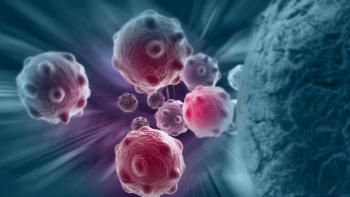
Switching Therapies in Steroid-Refractory Chronic GvHD
An expert in hematology-oncology comments on the importance of early detection and intervention of steroid-refractory chronic GvHD [graft-versus-host disease] and considers approaches to switching treatments.
Episodes in this series

Matt Fowler: What’s the importance of early detection and, specifically, early intervention of this steroid-refractory disease?
Yi-Bin Chen, MD: The importance of early intervention for chronic graft-vs-host disease or steroid-refractory chronic graft-vs-host disease has been debated. We all believe that if we had better tools for therapy, then we could change the natural history for certain patients if we acted earlier. If you look at any patient with chronic graft-vs-host disease, especially steroid-refractory chronic graft-vs-host disease, there’s likely a component of their disease that cannot be reversed. As I tell patients, when they have established steroid-refractory chronic graft-vs-host disease, there’s an element of irreversibility. Then there’s an element of reversibility that we’re trying to fix to make life better, symptoms better, the exam look better, the skin look better, and so forth. We don’t know what percentage is fixed and what percentage is reversible in each patient.
I’m humbled every time that I treat patients, because I don’t know. It’s definitely based on their obvious response to certain treatments. If we act earlier, certainly in the steroid-refractory setting, then we’ll have a much better chance of reversing end-organ damage, and we’ll have a much better chance of avoiding irreversible end-organ damage, especially if we have effective agents. That’s true only if we have interventions that are effective at controlling the process. Overall, it definitely pushes for earlier detection, whether for steroid-refractory or initial chronic graft-vs-host disease. Part of that is the patient needs to understand what we’re looking for. Part of that is the providers need to do an accurate assessment. Part of that is developing effective therapeutics to make that matter.
Matt Fowler: To wrap up this section, could you talk about when you consider switching treatments? What approaches would you take when initiating a switch?
Yi-Bin Chen, MD: Going back to when we should initiate second-line therapy for chronic graft-vs-host disease gets to the definition. Practically, if I start systemic steroids for a patient with chronic graft-vs-host disease and at a month’s time in follow-up, they haven’t improved, then I’ll start a second-line agent. If during that month they’re clearly worsening, then obviously they need something else. It’s the minority of patients who are clearly changing during that month. Those are 2 subsets. The third subset is those patients who are steroid dependent. If patients have a benefit or a partial response from steroids, then as we lower the steroids and those symptoms come back, we’ll increase the steroids to an effective dose but add a second-line agent to allow the patient to come off steroids a bit better than they were before. Then there’s the fourth population, in which I know steroids will be harmful. I start a second-line therapy at that point, which is used as the first line for them.
Matt Fowler: What’s the importance of early detection and, specifically, early intervention of this steroid-refractory disease?
Yi-Bin Chen, MD: The importance of early intervention for chronic graft-vs-host disease or steroid-refractory chronic graft-vs-host disease has been debated. We all believe that if we had better tools for therapy, then we could change the natural history for certain patients if we acted earlier. If you look at any patient with chronic graft-vs-host disease, especially steroid-refractory chronic graft-vs-host disease, there’s likely a component of their disease that cannot be reversed. As I tell patients, when they have established steroid-refractory chronic graft-vs-host disease, there’s an element of irreversibility. Then there’s an element of reversibility that we’re trying to fix to make life better, symptoms better, the exam look better, the skin look better, and so forth. We don’t know what percentage is fixed and what percentage is reversible in each patient.
I’m humbled every time that I treat patients, because I don’t know. It’s definitely based on their obvious response to certain treatments. If we act earlier, certainly in the steroid-refractory setting, then we’ll have a much better chance of reversing end-organ damage, and we’ll have a much better chance of avoiding irreversible end-organ damage, especially if we have effective agents. That’s true only if we have interventions that are effective at controlling the process. Overall, it definitely pushes for earlier detection, whether for steroid-refractory or initial chronic graft-vs-host disease. Part of that is the patient needs to understand what we’re looking for. Part of that is the providers need to do an accurate assessment. Part of that is developing effective therapeutics to make that matter.
Matt Fowler: To wrap up this section, could you talk about when you consider switching treatments? What approaches would you take when initiating a switch?
Yi-Bin Chen, MD: Going back to when we should initiate second-line therapy for chronic graft-vs-host disease gets to the definition. Practically, if I start systemic steroids for a patient with chronic graft-vs-host disease and at a month’s time in follow-up, they haven’t improved, then I’ll start a second-line agent. If during that month they’re clearly worsening, then obviously they need something else. It’s the minority of patients who are clearly changing during that month. Those are 2 subsets. The third subset is those patients who are steroid dependent. If patients have a benefit or a partial response from steroids, then as we lower the steroids and those symptoms come back, we’ll increase the steroids to an effective dose but add a second-line agent to allow the patient to come off steroids a bit better than they were before. Then there’s the fourth population, in which I know steroids will be harmful. I start a second-line therapy at that point, which is used as the first line for them.
Transcript Edited for Clarity
Newsletter
Stay up to date on recent advances in the multidisciplinary approach to cancer.


















































































